|
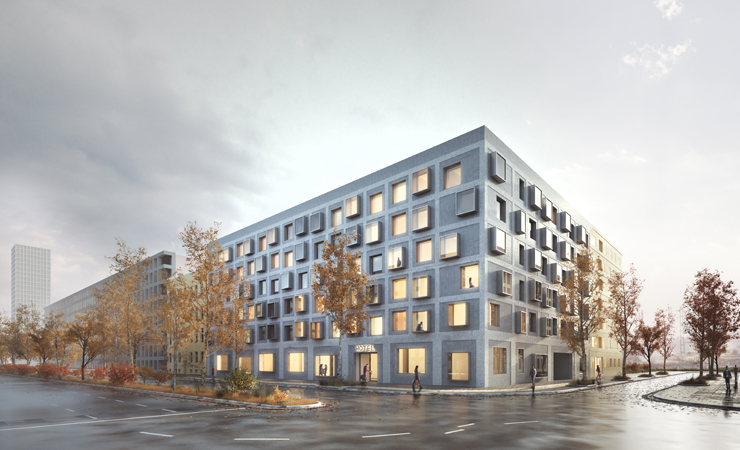
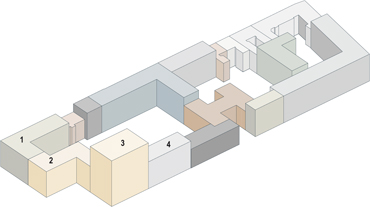
|
|
The two southern blocks of the masterplan for Quartier Heidestrasse form an urbanistic exception - the new buildings are clustered in between existing volumes - party used for housing, partly commercial - and linked into one big city block. In contrast to the overall area of the Europa City, the buildings are part of a paramount urban structure. The design reflects this situation by combining the different functions of hotel, free sector and social housing into distinguished but related blocks. According to the various usage, the building parts are differentiated by facade expression, color and material. They are connected by common elements that visualize the contextual coherence. The concept of a fragmented formation correspond to the direct surrounding of the mixed use area and reacts as plausible complement to the superstructure of the adjacent block.
volumes, usage
The arrangement of functions follows a sequential gradation of public frequency, starting from Heidestrasse till the green area in the West - expectably from very busy at Heidestrasse, to the less frequented Planstrasse till the green edge orientated to the railway tracks.
|
The location for the hotel at the corner Heide- / Planstrasse is given (1). A small retail area is located next to the ramp to the underground garage. The adjacent double fold volume (2) - including the tower orientated towards the public square (3) - contains the social housing with 220 units. The free sector housing is located in the quiet southwestern wing (4).
This arrangement enables clear addresses and pledges for
little friction between the different functions.
The upper floors of the south wing are filled with apartments, the day care is located in the ground floor parallel to the western green space with sports and leisure facilities.
The courtyard garden of the day care center has no basement and is therfore suited for large trees and a topographic playground.
In order to meet the requests of the masterplan, the envelop is adjusted for a better usage of buildings and outdoor spaces. The relevant height lines of the block and the maximum floor area are kept.
|
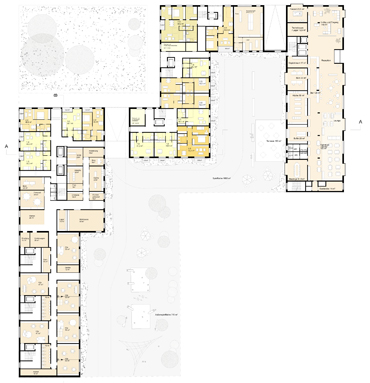
|

* Two meters are added to the ground floor of the southwest wing to accommodate suitable and sufficient space for the day care.
* The hotel part along the Heidestrasse is widened by one meter to efficiently fit the rooms on both sides of the corridor.
* The 6000 m2 / 180 hotel rooms require a shift of the separation between hotel and housing by 10 meters. Consequently the building line perpendicular to the Planstrasse is moved by three meters to the plot boundary. The proportions of the inner courtyard between hotel and housing is enhanced and the housing corner fits a proper apartment size.
* Within the permissible height, a twelfth floor is added to the tower in order to gain 12 apartments and a more accentuated volume.
|
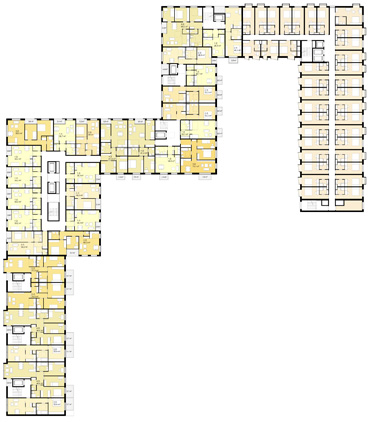
|
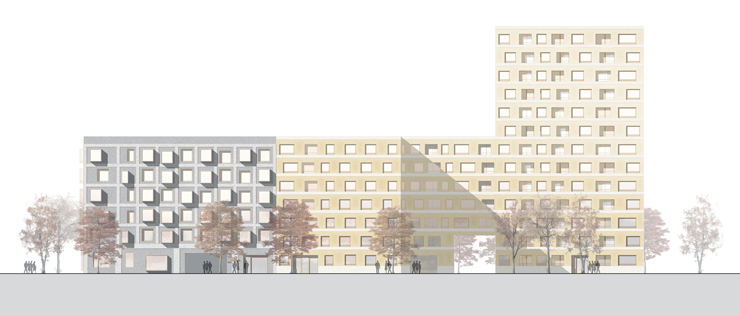
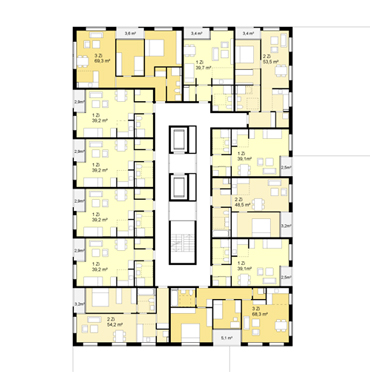
|
|
architecture / facade
The light plaster facades of the hotel and the free sector housing are sculpturally articulated by bay windows. All facades of the different volumes are layered and visually bind together by horizontal bands of a lighter surface with rough texture.
The three building parts are shimmering slightly by a metallic effect coating with a silver, gold and light grey tint.
hotel
A various pattern of aluminum clad bay windows on two different heights serving as sitting niches breaks the monotonous array of the hotel rooms. The vivid rhythm follows the 30% rule for balconies. The oriels at the garden side are slanted in order to direct the view towards the south instead of to the opposed housing block.
|
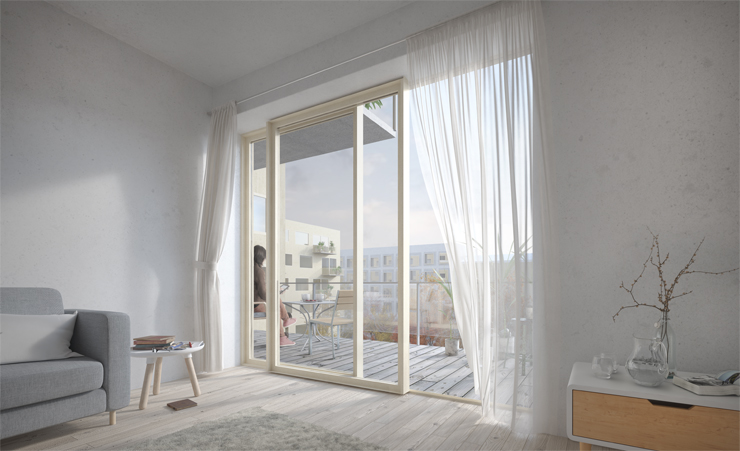
The facade of the social housing is structured by horizontal bands that align the windows and loggias. Slightly shifting positions of the openings alternate the repetitive pattern of the stacked apartments.
The loggias are only ‚optically shifted', the volumes including insulation are in fact on top of each other.
The housing mix reflects the high demand on affordable small units. In the plinth are many double oriented apartments with sleeping rooms towards the quiet courtyard side. The tower arrays a ring of single room units around the core, the corners comprise two room types. |
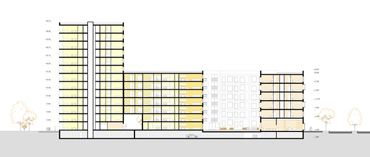
|
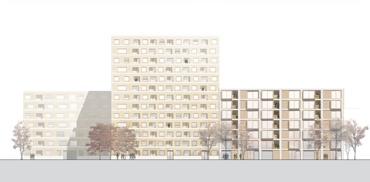
|
|
The outer facade of the free sector housing shows an alternating rhythm of large bay windows and flush panels. Planters are added onto the railing of the loggias in front of the lift. The garden side is structured by pairs of spacious balconies.
All units behalf the studios are two sided and orientated towards East and West.
The vast openings of the bay windows let daylight penetrate deep into the units. The staircase is naturally ventilated through the loggia. The positions of shafts and load bearings walls allow various combinations of unit types.
|
All housing units are equipped with outdoor spaces - balconies towards the garden and loggias to the streets. The loggias can be closed by sliding glass panels. The bay windows are fitted with the triple glazing for sound proofing.
logistics
Entrance hals and staircases are naturally ventilated and spacious with room for strollers and walkers. All floors are accessed by disabled, the social housing on ground floor is lifted by 0,5m - the day care and hotel are situated on ground level. Only the restaurant and lounges are lifted by three steps. |
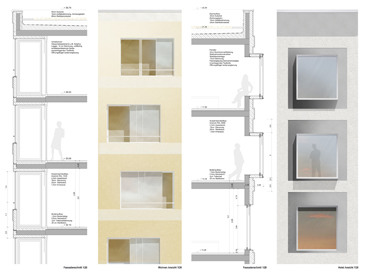
|
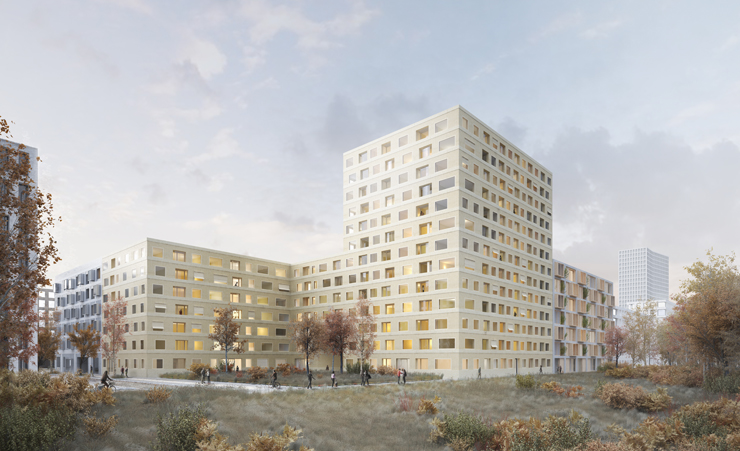
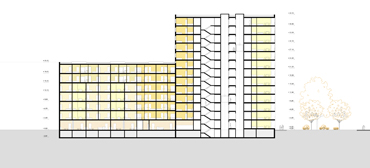
|
|
Design Team: morePlatz, OZ Architect
morePlatz: Johannes Schele, Caro Baumann, Martin Muc
OZ Architect: John Bosch, Maarten Verhelst
Model: Made by Mistake
Client: Quartier Heidestrasse
Area: 32.400 sqm, 230 Wohnungen, Hotel, Kita
Project Year: 2017
renderings © Lukas Hofmann
|
back |












